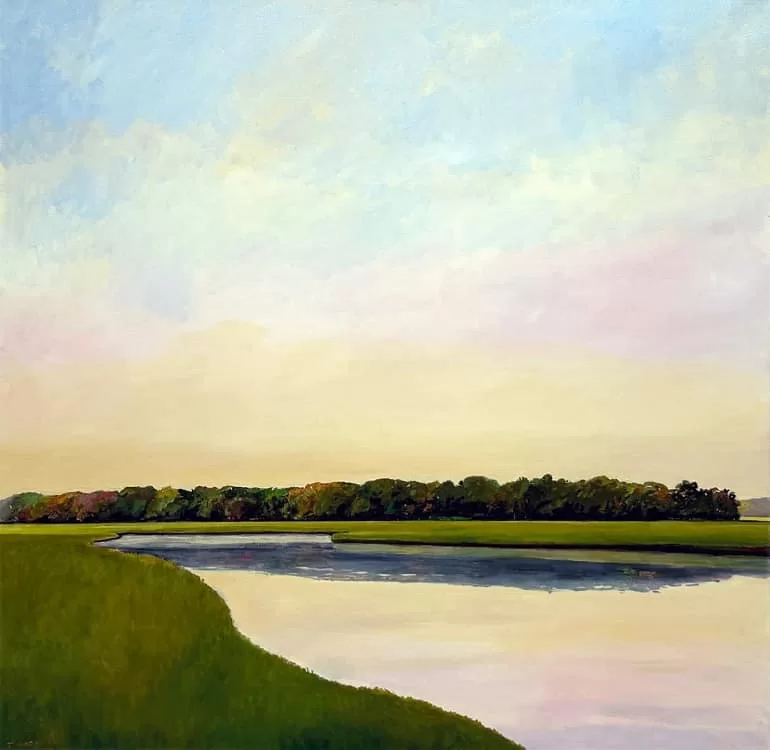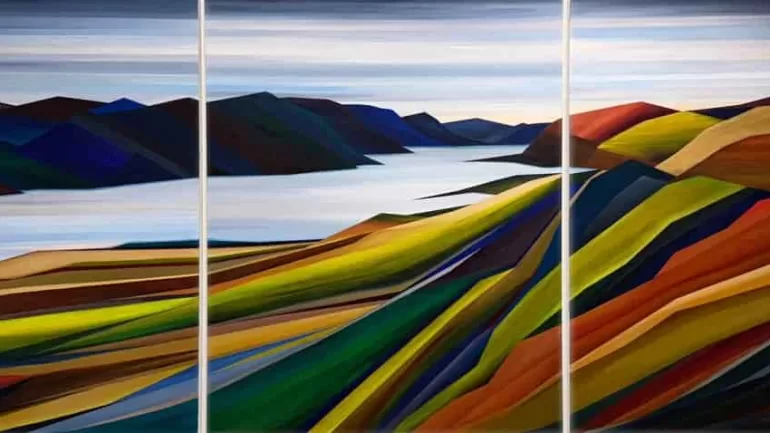ART
A bold exhibit of contemporary landscape art at Gallery Henoch blends memory, motions, and nature’s raw beauty.
BY KAZEEM ADELEKE, ARTCENTRON
NEW YORK, NY– In a time when environmental concerns continue to escalate, Landscapes at Gallery Henoch offers a moment of visual clarity and emotional grounding. The show invites viewers to reconnect with the natural world through the eyes of five of today’s most compelling contemporary artists. Rebecca Stenn, Jon MacAdam, Anita Mazzucca, Ionna Stefou, Eric Zener, and John Evans offer a new way of interpreting landscapes. Contemporary Landscape Art. Rather than offering traditional scenic views, their works interpret nature as a living, breathing entity—shaped by movement, memory, and emotion. Their new thinking gives credence to contemporary landscape art.
Landscapes is not just a visual experience but a philosophical one, challenging how we define and relate to the idea of “place.” From sweeping mountain vistas to introspective marshlands and stylized flora, each piece unveils a different layer of Earth’s story. These artworks capture both the visible and the invisible—the tangible terrain and the emotions it stirs. Landscapes feels both timeless and timely, merging artistic mastery with urgent ecological relevance. It’s a space where viewers can slow down, reflect, and rediscover their connection to the land. This show stands as a testament to the enduring power of nature to inspire, provoke, and heal.
A Journey Through Contemporary Landscape Art
Landscapes brings together leading voices in contemporary painting to capture nature’s complexity. From tranquil pastures to jagged coastlines and metropolitan silhouettes, the artworks push the boundaries of landscape painting. Visitors are drawn into layered compositions where brushwork, color, and structure speak as one unified language.
Rather than capturing static views, these paintings depict emotional terrain—memories, movement, and meaning embedded in place. Each artist contributes a unique stylistic voice, offering new ways to witness and remember our surroundings.
Rebecca Stenn: Dance, Movement, and Painted Terrain
Rebecca Stenn, a celebrated dancer and choreographer, brings dynamic energy to the canvas. Her works flow with rhythm, translating bodily motion into visual form. She sees landscapes not just as vistas but as moving compositions of line and geometry.
Her Queen’s Robe Triptych stands out as a monumental visual journey. Bold arcs and intersecting hues mimic both geological forces and the quiet flow of air and water. Every panel feels alive, as though breathing with the landscape it represents.
Stenn’s intimate connection to the Columbia River Gorge—especially Dog Mountain and Crown Point—infuses her pieces with authenticity. Her abstract approach elevates rather than obscures the landscape’s grandeur. In her piece Morning, subdued tones of grey and blue depict dawn’s first light over the gorge, rendering a moment both silent and powerful.
Jon MacAdam: Landscapes Rooted in Memory
Jon MacAdam offers a reflective counterpoint. Working primarily in Vermont and the Hudson River Valley, he begins his process with small plein air sketches. These are transformed in the studio into expansive, layered compositions.
His repeated visits to the same locations echo Cézanne’s meditative method. Each painting is not just a view—it’s a reflection of time spent, light studied, and emotions recalled.
In MacAdam’s marshland scenes, the shimmering quality of water and foliage is captured through subtle glazing techniques. These are not generic places, but sacred, lived spaces—often shared with his children. His work expresses a quiet reverence that grows stronger with every layer of paint.

Anita Mazzucca: Capturing Nature in Hyperreal Detail
Anita Mazzucca’s approach offers striking clarity. Her landscape paintings border on photographic realism, but with a soul that transcends the camera lens. Trimmed Trees deceives the eye at first glance—but a closer look reveals hand-rendered details and deliberate brushwork.
Her standout piece, A Field of Wild Sunflowers, pulses with life. Inspired by pointillism, it uses rhythmic brush marks to capture texture and movement. The light and structure create an atmosphere both exacting and poetic. Mazzucca masterfully balances hyperrealism with emotional nuance.
A Spectrum of Artistic Perspectives
Other notable contributors include Ionna Stefou, whose marine works stir deep emotion, and John Evans, who explores urban-natural boundaries with textured abstraction. Each artist redefines the idea of a landscape—not just as a physical location but as an emotional experience.
Is a landscape what we see or what we feel? Landscapes at Gallery Henoch dares to ask—and answer—this question from many artistic angles.
Reimagined Contemporary Landscape Art
This exhibition resonates with urgency and reverence. It’s not only a celebration of technique—it’s a reflection on how we connect to our planet. Each piece serves as a reminder that land is not just background but story, spirit, and memory.
In an era where natural spaces face constant threat, this show underscores our shared responsibility to see, value, and preserve what remains. Landscapes inspires viewers to engage emotionally with the Earth—and perhaps, to protect it.
- Featured Image: Rebecca Stenn, Queen’s Robe, 2025.Acrylic on canvas 60x 144 in.152.4 x 365.8 cm. Image: Gallery Henoch
